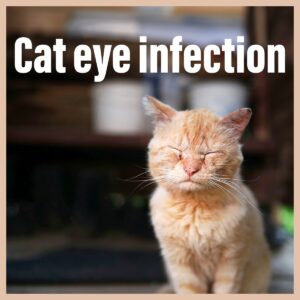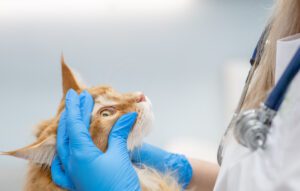Cat Eye Infection: Causes, Symptoms, and Treatments
 Cats, with their expressive and playful eyes, often exhibit signs of discomfort when they’re suffering from eye infections. As a responsible cat owner, it’s essential to recognize the symptoms, understand the causes, and know the appropriate treatments to ensure your feline friend’s eye health. In this blog, AZPetVet will dive into cat eye infections and help provide vital information so pet owners can be prepared for any situations that may arise.
Cats, with their expressive and playful eyes, often exhibit signs of discomfort when they’re suffering from eye infections. As a responsible cat owner, it’s essential to recognize the symptoms, understand the causes, and know the appropriate treatments to ensure your feline friend’s eye health. In this blog, AZPetVet will dive into cat eye infections and help provide vital information so pet owners can be prepared for any situations that may arise.
Types of Cat Eye Infections
As we delve into understanding cat eye infections, it’s important to recognize that cats are susceptible to a range of different eye issues. From mild irritations to more serious infections, the variety of conditions that can affect a cat’s eyes highlights the importance of pet parents to monitor and provide proactive care. By gaining insight into the types of eye infections that cats may encounter, cat owners can better equip themselves to identify symptoms early and seek prompt and effective treatment.
Some of the different types of eye infections in cats include:
Conjunctivitis
So, what is Conjunctivitis? Commonly known as pink eye, conjunctivitis is the most prevalent form of eye infection in cats. Characterized by an inflammation of the thin membrane covering the inside of the eyelids and white part of the eye. Conjunctivitis can be caused by viral or bacterial infections, allergies, or irritants like dust and smoke. Common symptoms to look for may include redness in the white parts of their eyes, increased ocular discharge, eye swelling, squinting, and increased tear production. If left untreated, conjunctivitis can lead to blindness.
Blepharitis
Blepharitis, an inflammation of the eyelids, can result from various irritants affecting cats’ eyes, like bacterial infections, allergies, or underlying health issues. Symptoms that you should be on the lookout for are redness, swelling, crusting, or discharge, often accompanied by itching and discomfort. Cats may excessively itch and rub their faces and eyes, causing further tissue trauma. Untreated blepharitis can lead to chronic discomfort, eyelash loss, or corneal damage.
Uveitis
Uveitis is the result of inflammation of the uvea (the structure beneath the whites of the eye) and is one of the more painful eye conditions for cats. This type of condition can occur suddenly or develop slowly, remaining hidden for a long time. This can be caused by corneal ulcers, eye trauma, cataracts, tumors, and other autoimmune or underlying conditions.
Keratitis
Resulting in the inflammation of the cornea, keratitis is caused by infections, eye trauma, environmental irritations, or accompanying underlying conditions. Be on the lookout for symptoms such as redness, corneal cloudiness, excess discharge, signs of eye discomfort, and a sensitivity to light.
Corneal Ulcers
Corneal ulcers are typically caused by trauma to the eyes (rubbing against a rough surface, or laceration from a sharp object), bacterial infections, viral infections, or accompanying other underlying conditions. Corneal ulcers result in open wounds or sores on the cat’s cornea, causing immense pain. Due to this extreme pain, cats may begin to excessively rub the affected eye, other symptoms include rapid blinking, squinting, and discharge.
Symptoms of Cat Eye Infections
 Identifying an infected cat eye is crucial for prompt treatment, and it is difficult to accurately diagnose the type of eye infection your cat is experiencing, making it even more important to stay vigilant of the following general symptoms. If you feel your cat is experiencing any of the symptoms listed, take them to your nearest AZPetVet, and our experienced vet staff will be able to properly diagnose and treat your beloved cat.
Identifying an infected cat eye is crucial for prompt treatment, and it is difficult to accurately diagnose the type of eye infection your cat is experiencing, making it even more important to stay vigilant of the following general symptoms. If you feel your cat is experiencing any of the symptoms listed, take them to your nearest AZPetVet, and our experienced vet staff will be able to properly diagnose and treat your beloved cat.
Swelling
Swelling around the eye area is a common symptom of cat eye infections. It may affect one or both eyes and can vary in severity. In some cases, the swelling may be accompanied by redness and warmth around the eye.
Discharge
The presence of discharge from the eyes is another telltale sign of infection. The discharge may be watery, mucous-like, or purulent (containing pus). Be on the lookout for clear, green, or yellow discharge coming from the eyes of your cats.
Squinting
Cats experiencing eye discomfort often squint or partially close their eyes to alleviate pain. Squinting can also be a protective mechanism to shield the eye from further irritation or injury. Persistent squinting should prompt a visit to the vet for evaluation and treatment.
Cat Eye Boogers
Cat eye boogers, or crusty debris accumulating in the corners of the eyes, are a common occurrence, especially in cats with eye infections. These boogers may vary in color and consistency depending on the underlying cause. Regularly cleaning the eye area can help prevent the buildup of discharge and debris. If the buildup persists on the skin, it could create secondary skin infections which can exacerbate the problem. In order to prevent this, you can clean this discharge with a warm, wet washcloth.
If your cat has occasional eye boogers, no need to worry, `infrequent eye discharge does not need to raise alarm bells. On the other hand, chronic eye discharge is something that will need to be addressed through veterinary treatment.
What Does an Infected Cat Eye Look Like?
Affected eyes may appear red, swollen, and irritated. You may notice excessive tearing or discharge, ranging from clear to yellow or greenish in color. Cats may also exhibit behaviors like squinting or rubbing their eyes excessively due to discomfort.
In serious cases you cat may have bloody discharge, if this happens you need to take your cat to see a veterinarian immediately.
Causes of Cat Eye Infections
Cat eye infections can be caused by several factors, including viral and bacterial pathogens, allergens, irritants, and underlying health conditions. Common causes include:
Bacterial and Viral Infections
Pathogens such as chlamydia, herpesvirus, and calicivirus can cause infectious conjunctivitis in cats. These infections can be contracted through direct contact with an infected cat, infected surfaces, or being in the same area as another cat as these bacteria can be airborne.
Allergies
Cats can develop allergic reactions to environmental allergens like pollen, dust, or mold, leading to inflammation and eye irritation. To learn more, check out our blog on springtime allergies here.
Trauma
Injuries to the eye, such as scratches or foreign bodies, can introduce bacteria and trigger infections.
Underlying Health Issues
Conditions like feline upper respiratory infections (URI), feline immunodeficiency virus (FIV), or feline leukemia virus (FeLV) can weaken the immune system and make cats more susceptible to eye infections.
Treatments for Cat Eye Infections
Effective treatment of cat eye infections depends on the underlying cause and severity of the condition. In mild cases, home care and supportive measures may suffice, while more severe infections require veterinary intervention. Some treatment options include oral antibiotics, eye drops, topical solutions, and pain relief medications.
Can You Treat a Cat Eye Infection at Home?
While some mild cases of cat eye infections may improve with home care, it’s essential to consult with your AZPetVet veterinarian for proper diagnosis and treatment plan. Home care measures may include:
Gentle Cleaning
Use a soft, damp cloth to gently wipe away any discharge or debris from the eye area. Avoid using harsh chemicals or solutions that may irritate the eyes.
Warm Compresses
Applying a warm, moist compress to the affected eye can help soothe irritation and promote drainage of discharge.
Environmental Management
Minimize exposure to potential allergens or irritants that could exacerbate the infection. Keep the living environment clean and take steps to minimize your cat’s exposure to dust, mold, and mildew.
Will a Cat Eye Infection Heal on Its Own?
In some cases, mild cat eye infections may resolve on their own, especially if they’re caused by environmental irritants or allergens. However, it’s essential to monitor the condition closely and seek veterinary care if symptoms persist or worsen. Untreated infections can lead to further complications including vision loss.
 When to Take Your Cat to the Vet
When to Take Your Cat to the Vet
Here are some indicators that it’s time to take your cat to the vet:
Persistent Symptoms
If your cat’s eye symptoms don’t improve or worsen despite home care measures, it’s time to consult a vet.
Severe Discharge
Excessive discharge from the eyes indicates a more serious infection that requires medical attention.
Pain or Discomfort
If your cat shows signs of pain, discomfort, reluctance to open its eyes, or is constantly rubbing their eyes, it’s a sign of a significant issue that needs immediate attention.
Changes in Behavior
Any changes in your cat’s behavior, such as lethargy, loss of appetite, or increased aggression, could indicate an underlying health problem requiring veterinary care.
Changes Inside the Eye or Cornea
Any changes to the inside of the eye, including haziness, “bluing” of the eye, changes in eye color, evidence of brown or black spots, or whitening of the cornea may indicate more serious conditions and prompt diagnosis and treatment is vital to preserve vision.
Bleeding in or Around the Eyes
If you see blood in or around the eyes, consider this an emergency and seek prompt treatment. Bleeding in the eyes can also be a sign of systemic illness which may be life threatening.
Sudden Blindness
Cats are masters at hiding mild vision loss in the early stages and are prone to sudden losses of vision. If your cat seems to be having vision problems, seek veterinary care immediately.
Photophobia
Photophobia means sensitivity to light which can be seen when cats squint in bright lights or move their heads away from a light source. Cat eyes are much more sensitive to light than the human eye, so they often avoid bright lights. If you notice changes in your cat’s ability to tolerate light, seek veterinary care immediately.
Visit a Nearby AZPetVet Location
If you notice any signs of eye infection in your cat, it’s crucial to go to your nearest AZPetVet location promptly. While mild cases may be managed with home care, persistent or severe infections require professional evaluation and treatment.
Cat eye infections are common but treatable conditions that require prompt attention and appropriate care. By understanding the causes, recognizing the symptoms, and seeking timely veterinary intervention, you can ensure your feline companion enjoys optimal eye health and wellbeing. Remember, your AZPetVet veterinarian is your trusted partner in safeguarding your cat’s ocular health, so don’t hesitate to seek their guidance and expertise when needed. Find a AZPetVet location near you to request an appointment for your cat.

